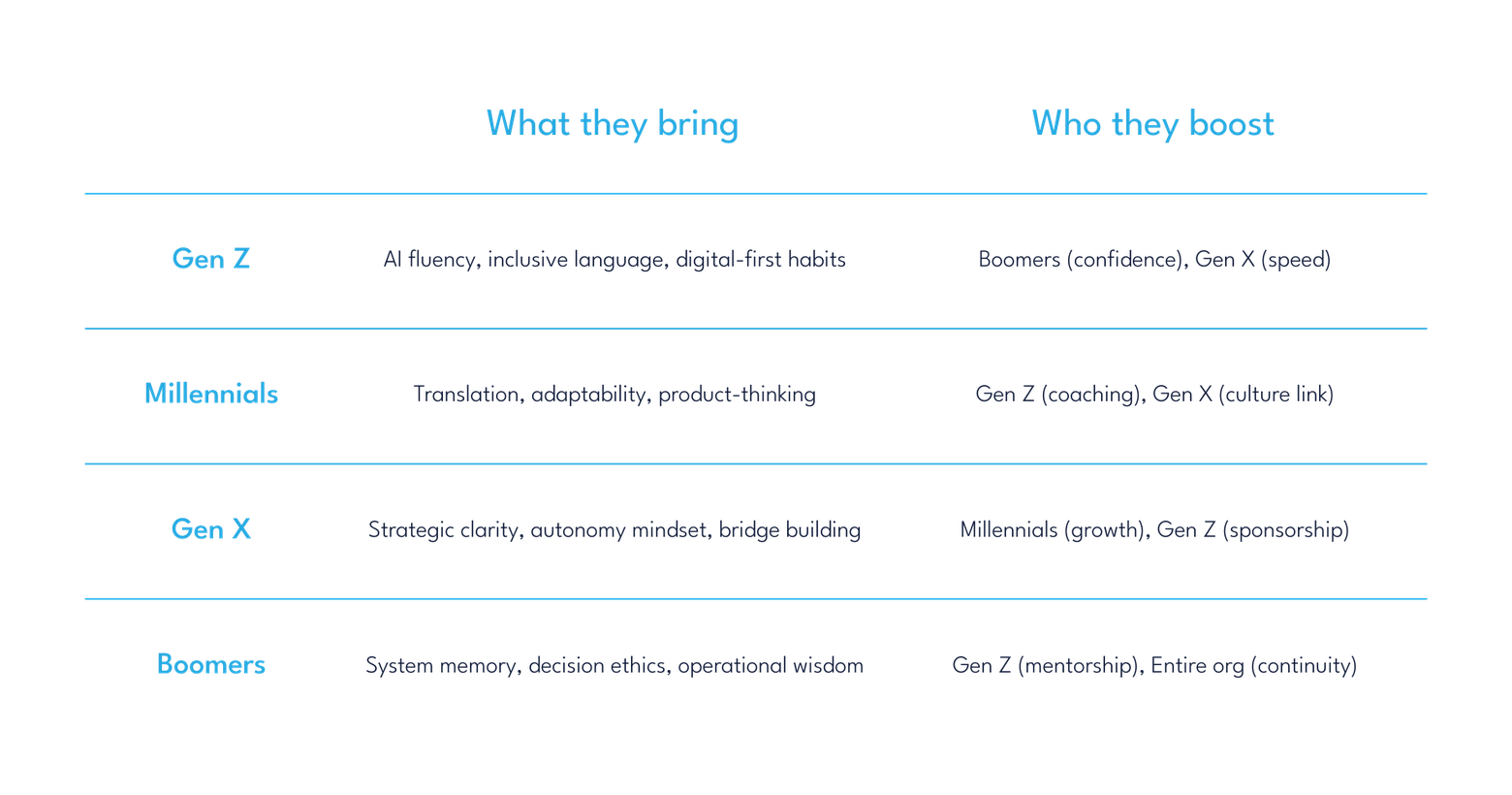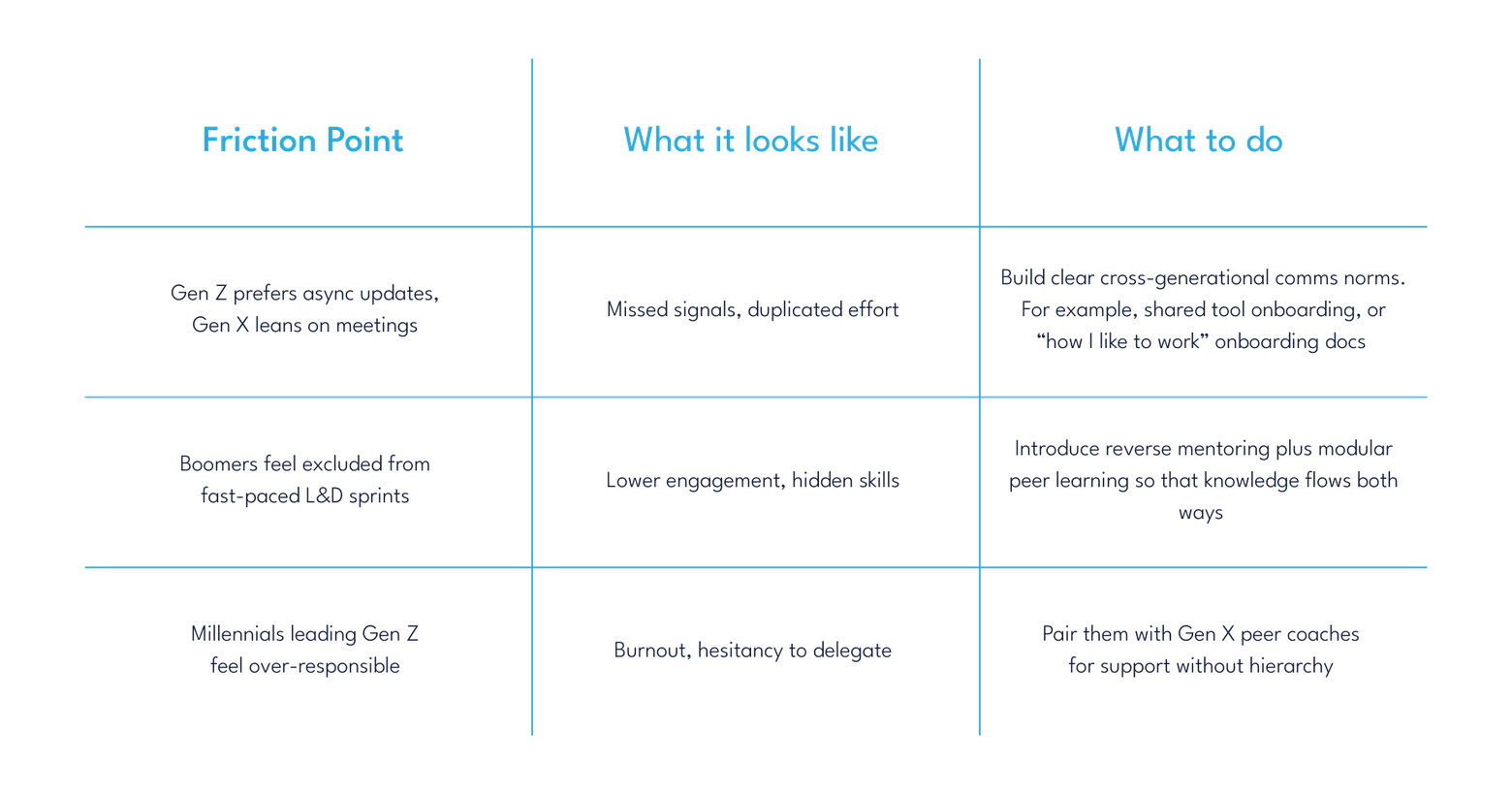How to Attract and Retain Multi-Generational Tech Talent in 2025

Why bridging age groups unlocks the best of your tech workforce
In today’s tech teams, it’s not unusual to see a graduate software engineer and a late-career transformation lead working side by side. And that’s a good thing.
What happens when four generations come together – each with different perspectives, priorities, and ways of working? You get diversity of thought, yes, but you also get a powerful, resilient blend of pace, pattern recognition, and problem-solving.
To unlock that potential, you need to move beyond the stereotypes. Forget the TikTok jokes about Boomer vs Gen Z.
The real story in 2025 is far more interesting: each generation is adapting, upskilling, and, importantly for employers, reevaluating what they want.
According to Talenza’s 2025 Tech & Transformation Talent Outlook (TTTO), tech professionals across every age bracket are open to making a move. Over 60% of every generation is planning to change employers this year. And this might surprise you: a whopping 70% of Boomers plan to make a move.
That’s more than a retention crisis, and it’s probably time to realign your EVP. Because the reasons people are moving vary widely depending on what stage of life, career and capability they’re in.
Here’s how to meet each generation where they are and build a workplace where everyone feels they belong. We’ll cover:
- Gen Z snapshot (and what motivates them to stay or go)
- Millennials snapshot
- Gen X snapshot
- Boomer snapshot
- How to gain a cross-generational advantage
- What happens when tensions grow (and why is it a good thing?)
- How to design a team for everyone
Make sure you read to the end, where we discuss how to bring everything together for high retention and even higher performance. Let’s begin with your youngest team members.
Gen Z (13–28): Hungry, capable, and watching closely
Gen Z is still the smallest slice of Australia’s tech workforce (just 4.6% in Melbourne, for instance). But don’t mistake small for soft. This group is shaping the cultural and capability expectations of tomorrow’s tech industry, and they’re not waiting to be invited in.
More than 62% plan to leave their current role this year. What’s driving them? A hunger for growth, and a sharp eye on value.
According to Talenza data from the TTTO:
- 59% want career progression
- Nearly 50% rate long-term job security as critical
- And 17% say boosting their salary is their top work-life concern, followed closely by upskilling at nearly 16%
But here’s what’s interesting: 40% of Gen Z used their L&D budgets in the past year. This group isn’t just talking about upskilling. They’re doing it. Many are building fluency in emerging technologies (AI, automation, XR design) far faster than their more senior colleagues. Not to mention their instinct for inclusive language, user advocacy, and content accessibility.
They’re also values-driven. The 2025 Deloitte Gen Z and Millennial Survey shows younger workers are prioritising wellbeing, meaningful work, and real growth over prestige alone.
What you can do as an employer:
- Make career growth visible
- Create peer-led learning programs
- Avoid rigid hierarchies – Gen Z thrives in flat, collaborative cultures
Now, let’s see how all of that compares to Millennials.
Millennials (29–44): Ready to rise on their own terms
Millennials still make up the largest share of the tech workforce. And while this group is often unfairly cast as restless, the data paints a different picture in 2025.
Yes, 60% are considering a job change. But many are doing it strategically – pursuing better alignment as well as advancement.
According to the TTTO:
- 56% want career progression
- 55% value flexible working arrangements
- Over 50% cite salary and work-life balance as top priorities
Millennials are also in their career prime. 35% sit at senior level, 19% are managers, and many are stepping into tech leadership and strategic delivery roles.
Insight Global discusses the way Millennials can be the connective tissue between Gen Z’s desire for autonomy and Gen X’s need for structure. They translate cross-generational working styles and drive collaboration. Recognising them as translators allows employers to leverage their adaptability.
But they’re juggling a lot. Family, leadership, side hustles, and big personal goals. So the employers winning them over aren’t just paying well. They’re designing work around real lives.
What employers can do:
- Offer unambiguous autonomy
- Offer flexibility, but pair it with clear expectations. Autonomy works best when people know what success looks like, so define the outcomes, not just the hours.
- Respect energy management (trust matters more than task lists)
- Bridge generational thinking intentionally
Let’s move on to the next rung on the experience ladder – Gen X.
Gen X (45–59): Experienced, independent, and looking for substance
If Millennials are balancing act artists, Gen X are seasoned navigators. Nearly half of Australia’s tech workforce sits in this cohort. And many are holding the critical roles that drive strategy, delivery, and culture – managers (22%), directors (10%), and high-seniority specialists (35%).
And they’re not done growing. 62% are open to new roles, many as consultants or contractors. Their motivations are nuanced: they want flexibility, balance, and effective leadership.
They’re also more likely to cite poor management and lack of recognition as key reasons for leaving. Which makes sense; Gen X knows what “good” leadership looks like. And they’re not willing to settle.
What you can do as an employer:
- Build career paths that include consultancy and flexible contracting
- Elevate leadership capability (not just credentials)
- Re-skill with purpose: many Gen X professionals are doubling down on digital transformation, data governance, and platform optimisation
Something else to remember about Gen X is that they grew up without modern PCs and the internet. They moved from typewriters to smartphones; from dial‑up to DevOps toolchains. So (and this part is key), they don’t just know how to use technology. They know why it matters, and when to adopt it.
Media Culture calls this “digital dual citizenship”: they navigate both analogue and digital fluently, and they bring both critical judgment and practical innovation. That’s why they’re not just bridges between generations, they’re anchors in complex transformation – translating innovation into stable, scalable practice.
And one final note: Along with Millennials, Gen X can play the unspoken role of cultural bridge. They’ve worked under Boomers, mentored Millennials, and now collaborate with Gen Z. That pattern recognition? Invaluable.
Now, what does the Boomer cohort look like?
Boomers (60+): Seasoned, strategic, and surprisingly mobile
Let’s bust the biggest myth of all: Boomers aren’t checked out. In fact, they’re the most likely of any generation to be planning a move (70%).
And they’re hardly coasting toward retirement. They’re contributing meaningfully across government, enterprise, and scale-up contexts. Over 43% are in senior roles, 7% in C-suite positions, and many act as trusted consultants across transformation portfolios.
What matters most to them?
- 62% want flexible work
- 59% value interesting job content
- 55% still want attractive salary and benefits
Contrary to the stereotype, many Boomers are deeply engaged in mentoring, strategic uplift, and operational stability. Their tech fluency may vary, but their system fluency is unmatched.
What employers can do:
- Make the most of Boomer capability through advisory boards, reverse mentoring, and legacy platform modernisation
- Offer short-term contracts or project-based roles that allow them to contribute without overcommitting
- Honour expertise (recognition matters)
As Korn Ferry notes in their recent analysis, Boomers are becoming increasingly popular in the tech industry, especially in areas like regulatory compliance, cybersecurity oversight, and enterprise transformation.
The multi-generational advantage and who they help
Want to know what builds true resilience in a tech team? Diversity of timeline.
What do we mean by that? When one person remembers how we solved it last time, and another is dreaming up how to do it differently this time, you’ve got the kind of contextual intelligence that drives better decisions.
And that happens when generations stop working next to each other and start working for each other. Here’s a quick illustration of how the different generations can help each other.

So, as a team design leader, are you asking: “Do we have the skills?” Or, are you asking: “Where is the compound benefit?”
Where generations collide (and why that’s good)
Forget the memes. Tension between generations is where resilience is built and can drive growth.
- Gen Z challenges how things have always been done.
- Millennials question why it’s still being done that way.
- Gen X knows what will break if it changes too fast.
- Boomers remember when it last broke, and what fixed it.
But these differences aren’t always smooth (they don’t need to be). Is there some tension in your team currently? Maybe some miscommunication, frustration, or confusion? Try this.

Bottom line: your biggest talent advantage is in your team’s interactional diversity. So if your EVP isn’t nurturing those relationships, you’re missing out in so many ways. Together, multigenerational tech teams offer something no AI tool can replicate: context, constraint, and courage.
Tips for designing for everyone (without designing for no one)
We know one-size-fits-all doesn’t work anymore. Not for benefits. Not for flexibility. And definitely not for engagement.
What the most successful tech employers are doing now is designing experiences that flex by life stage, learning style, and motivation. It’s less about ticking a generational box and more about creating a culture that adapts as your people evolve.
So what’s worth trying?
- Multi-channel growth: Shadowing, skill sprints, lateral moves, and sabbaticals. Different generations define “progression” differently, so offer pathways that flex.
- Hybrid that’s human: Some want 3 days in the office. Some want none. The key is clarity, trust, and team norms that work.
- Meaningful moments: Not just milestone celebrations, but personal check-ins that ask: is this still working for you? What do you want to explore next?
In short: understand your people. Not just their age bracket, but their goals, blockers, and evolving needs. That’s how you attract, retain, and elevate great tech talent at every stage of the journey.
In 2025, your best talent is looking for alignment. And if you’re ready to meet people where they are, they’re more likely to stay for where you’re going.
Imagine a team made up of:
- A Gen Z UX researcher
- A Millennial product manager
- A Gen X delivery lead
- And a Boomer technical advisor
Now imagine that team wasn’t just diverse, but designed to draw out each other’s strengths.
- UX critiques become coaching moments
- Delivery hiccups prompt system rewiring
- The product roadmap is grounded in legacy insight and future user behaviour
Every daily stand-up becomes a micro-learning loop. Every decision is grounded in a range of experiences. This isn’t a fantasy. It’s what the most adaptive tech teams are doing now. And it starts with one question:
Are you designing teams that grow together?
Discover more insights in the 2025 Tech & Transformation Talent Outlook.